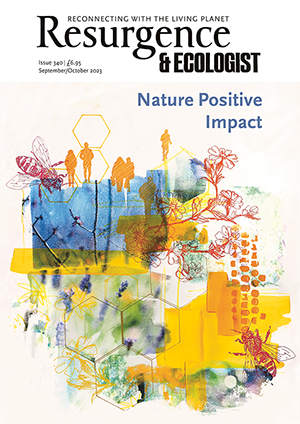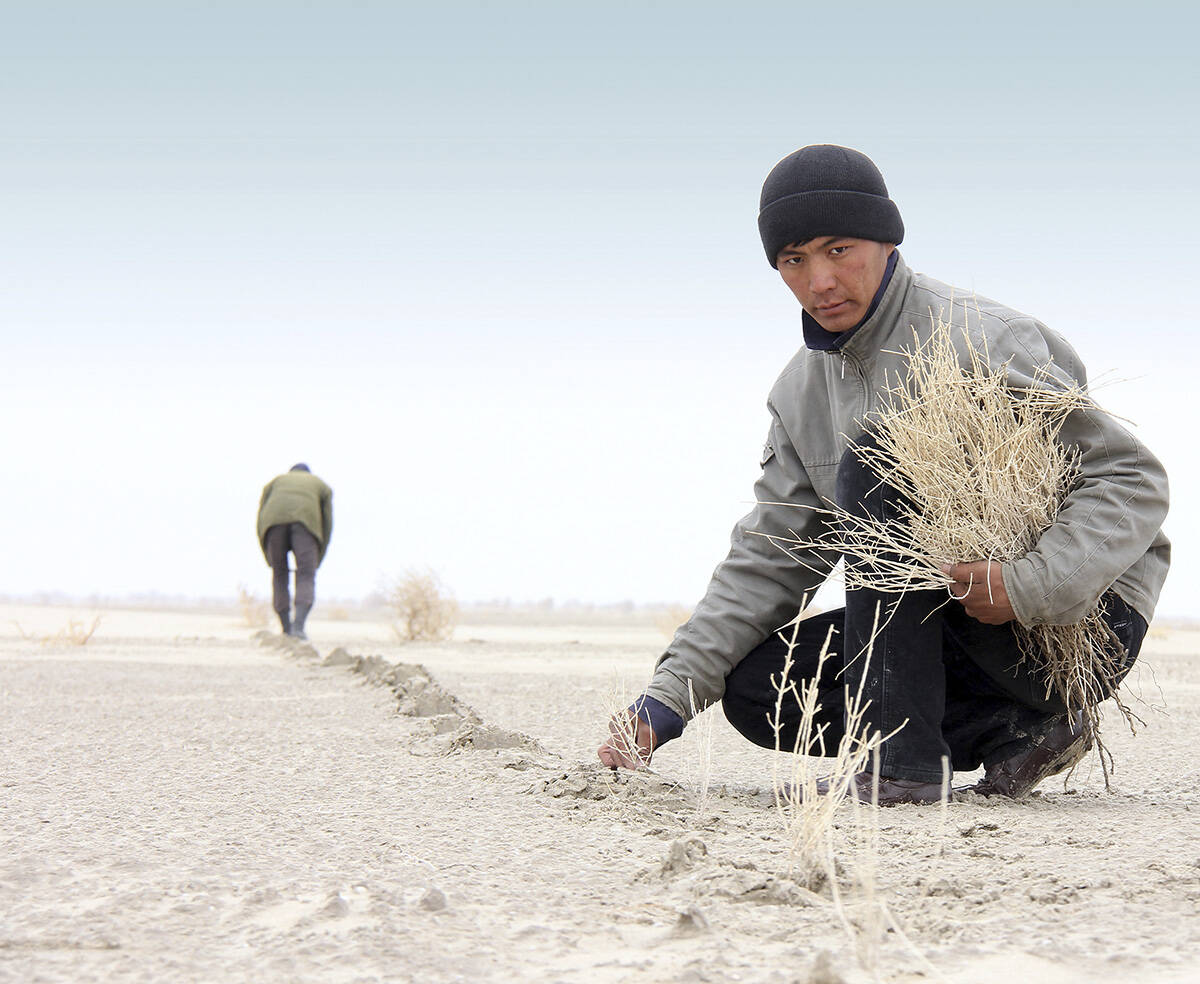When you imagine a familiar landscape critically impacted by climate change or human influence, what do you see? Parched agricultural lands, bone-dry waterways, or creeping desert? For many Karakalpaks and Kazakhs in the Aral Sea region, life is all of those things and more.
In 1960 the Aral Sea was the world’s fourth-largest inland water body, at 68,000 square kilometres, roughly the size of Tasmania or Sri Lanka. Its waters supported a commercial fishing industry employing upwards of 60,000 people, with ships ferrying people and cargo several hundred kilometres between Aralsk, Kazakhstan, and Muynaq, Karakalpakstan. Yet in 1961 the sea levels began decreasing by up to 90 centimetres per year. And by the early 2010s 90% of its volume had disappeared.
The culprit behind this tragedy was Stalin’s Great Plan for the Transformation of Nature, which was rolled out across the Soviet Union in the 1940s. Its aim was to boost agricultural productivity through hydrological projects and by afforesting the steppe to prevent drought and soil erosion. For the Aral this meant diverting the sea’s only sources of freshwater, the Syr Darya and Amu Darya rivers, to an extensive network of canal systems for irrigating the communist superpower’s vast cotton fields. This eco-crisis was, in truth, decades in the making, beginning in 1888 with the Russian Empire’s construction of a dam on the Murghab – an Amu Darya tributary – in Merv, Turkmenistan. The aim, according to Central Asia environmental historian Maya K. Peterson, was to turn the nearby imperial estate land into a model plantation for growing new crop varieties, in particular cotton and fruit. At the time, Merv was part of Russian Turkestan, as was much of the Aral Sea basin. Acquiring the land required decades-long military campaigns against the Khanates of Khiva and Kokand, as well as the Emirate of Bukhara. Unsurprisingly, the empire was keen to keep its territory indefinitely, so it was essential to make the land as fertile and hospitable as possible.
In 1912 Russian minister of agriculture Alexander Krivoshein visited Central Asia and ramped up the region’s irrigation projects big time, proclaiming the creation of a “new Turkestan” that would surpass the old one “in riches and level of culture”. An expanding Russian Empire and peasant-settlers from overpopulated central Russia in search of habitable land undoubtedly emboldened his vision for the arid Tsarist hinterlands.
Rivers in the Aral Sea drainage basin have a long history of damming, such as the Murghab in the Middle Ages, when it was under the rule of the Turko-Persian Seljuk Empire. However, for Stalin and his successors, their forerunner Krivoshein and the Russian Empire’s Turkestan-wide civil engineering projects instilled in them a level of ambition never seen in the Aral region, which ultimately transformed the sea into what it is today. In modern times the Aral Sea no longer exists, as its water levels have dropped some 20 metres since the 1960s, splitting it into separate lakes: the North and South Aral Seas, and the smaller Barsakelmes Lake sandwiched between them. At the turn of the 21st century, the South Aral Sea was over 180km wide from east to west, with the Palestine-sized Vozrozhdeniya Island in the middle. But over the years, it divided into an eastern and a western lobe, with a small channel connecting the two on the island’s north side.
In 2014 the eastern side dried up entirely for the first time in more than half a millennium. Today the remains of the desiccated seabed form the Aralkum, the world’s newest desert, comprising around 4 million hectares of sand dunes, salt flats and weather-beaten saline soil crystallised with fertilisers and pesticides from old agricultural field runoff. Occasionally strong winds blow across the desert, whipping up clouds of toxic salty dust that contaminate farmland and increase the risk of diseases such as oesophageal cancer in the local population.
Inevitably the stark environmental facts of the Aral have given it a sombre and hopeless reputation internationally. However, dotted around the seemingly inhospitable landscape are numerous conservation projects that offer the region a glimmer of hope. One shining example is the United Nations Development Programme’s Green Aral Sea initiative. In less than three years after launching, the team has planted well over 100,000 saxaul saplings in a 100-hectare area near the former eastern lobe of the South Aral Sea. When fully grown, each tree will fix and hold up to four tonnes of earth, helping to prevent desertification and the spread of toxic salts.
Currently Green Aral Sea is planting white and black saxaul (Haloxylon persicum and H. ammodendron), each sapling costing US$1 and paid for via an ongoing public crowdfunding campaign. However, the team’s long-term goal is to transform the entire former seabed into a verdant forest. This would provide a source of income for local families via managed wildlife hunting schemes.
In southern Karakalpakstan, horticulturist Natalya Akinshina and botanist Azamat Azizov have similarly ambitious plans for rejuvenating the Aral Sea basin by establishing honey gardens. They have pilot plots in the capital city of Nukus and in Bustan, where they are testing drought- and salt-tolerant flora that bloom continuously throughout the spring and summer. Through doing so, they hope to increase biodiversity, aid crop pollination by creating healthy bee populations, and improve the economy and food security by promoting agribusiness and agritourism.
Even on the remote Vozrozhdeniya Island positive change is afoot. A Darwin Initiative-funded project, led by conservation researcher Joseph Bull at the University of Kent and involving several international partners, has gained protected status for the island under a presidential decree. Currently they are in the process of supporting efforts to zone it, to ensure that endangered flora and fauna receive maximum protection. The saiga antelope, for example, is one of the most endangered species in the Aral Sea region because its horns are highly sought after by poachers. With zoning in place, stakeholders will be better able to prevent illegal hunting and ensure that the saiga have access to drinking water and unhindered movement and migration through the region.
After more than a decade of working with partners there, Bull says that local governments are making a fair amount of effort to improve the region, but stresses the importance of expanding transboundary cooperation and of ensuring that funding goes directly to the Aral’s affected regions for water management and infrastructure. Likewise, he says that there is plenty of scope for Nature-based solutions that build on (and learn honest lessons from) the current afforestation programmes. ”Deserts and drylands do not get the same degree of attention as forests and other habitats in global conservation terms, which is something that must change,” he says.
Details of the crowdfunding campaign for the sea plants can be found at www.greenaralsea.org
For more on the protection of the region’s endangered flora and fauna, visit www.saiga-conservation.org








